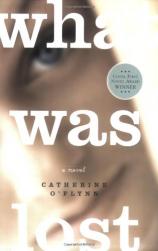What Was Lost
Review
What Was Lost
There’s something about precocious, bookish, lonely girls (I should know; I was one) that makes them excellent narrators: a rather literary vocabulary, a knack for not being noticed, a compulsion to write things down.
Such qualities come in handy when 10-year-old Kate Meaney embarks on a career as a private detective and establishes Falcon Investigations (the only other employee is a stuffed monkey named Mickey). As WHAT WAS LOST begins, it’s 1984, and we find Kate staking out Green Oaks, her local shopping center, in search of crimes and misdemeanors. It soon becomes clear that her pretend games are combined with real powers of observation. Kate’s descriptions of neighborhood merchants are funny and poignant (a butcher nobody patronizes much anymore, possibly because he “stood in his shop window, swatting flies against the sides of meat with a large palette knife”), and she nails elementary school herd behavior. When a new girl, Teresa, transcends all previous definitions of naughtiness, the class is shocked and disoriented, “like a small tribal culture whose cosmology is suddenly torn apart by the arrival of a box of cornflakes….” Kate also notices that Teresa has bruises and burns on her arms and legs, and is much smarter than she lets on.
This mix of Harriet the Spy-ish sardonic humor and dangerous reality runs through the entire novel; it soon develops that “what was lost,” in Kate’s case, was her father (her mother had already left), who drops dead one day, leaving her to the unsentimental care of her maternal grandmother, Ivy. Using a book called HOW TO BE A DETECTIVE, a gift from her father, Kate sets herself up as a professional watcher, keeping unbearable grief at bay with strict timetables (she allows herself only 10 minutes a day to play with her swivel chair) and systematic record-keeping (her father was a retired statistician). She also has a friend, Adrian, a kind, unambitious man in his 20s whose father runs the local newsagent/candy store and who treats Kate like an adult. She’s surviving pretty well, considering, when Ivy decides she’s too old to care for a child and resolves --- threatens is a better word --- to send Kate to Redspoon, a local boarding school with scholarships for bright kids.
Fast forward 19 years. We’re no longer in Kate’s head, but we’re in one of her favorite hangouts, the Green Oaks mall. While watching his screens on the night shift, a young security guard, Kurt, twice glimpses a little girl clutching a toy monkey (no one else sees her). Meanwhile, Lisa, Adrian’s younger sister, who also works at the mall --- as a beleaguered manager in a music superstore --- finds a toy monkey stuck behind some pipes. It turns out that Kate Meaney disappeared two decades ago, apparently vanishing into thin air after a trip to Redspoon to take the entrance exam. Adrian, treated by the police as a prime suspect in the case, absconds shortly thereafter. Are these sightings supernatural? Is the monkey a clue?
Catherine O’Flynn keeps the reader wondering about Kate’s fate, but this middle section of the book is less a mystery than a grim portrait of the community’s decline, circa 2003 --- lookalike chains stores instead of familiar shops and shopkeepers; huge, anonymous malls instead of factories where useful things are actually made. Kurt and Lisa epitomize the parallel loss of meaningful work, the paralyzing boredom and rage of imaginative people in dead-end service jobs, and their ruminations are both bitterly accurate and darkly funny (thinkClerks transplanted to the British Midlands): “Lisa sat in the window of Burger King consuming saturated fat and a large carton of sugar. …There was something in the air of Green Oaks that made everyone crave the complex non-flavors of highly processed, industrially honed calorific content, and Lisa was too tired to fight it today. Some of her colleagues … spent so much money on the stuff, she wondered if it wouldn’t be easier for them to be paid with a weekly shot of modified starches and trans fats….”
My only quibble is that O’Flynn seems a little too interested in her setting. A native of Birmingham, she knows the territory well and wanted, I suspect, to make a Big Statement about the post-industrial landscape. So there are digressions, and lots of them: quasi-sociological descriptions of mall culture and modern anomie that frequently have no direct bearing on the story. Kurt and Lisa’s voices are as captivating and smart, in their way, as Kate’s, but they sometimes feel a bit as if they belong to a different book.
Still, they are marvelous characters. And it is heartening to watch them meet, make a tentative, touching connection and begin to reconsider Kate’s case, probing their own almost forgotten memories. When the truth of what happened comes out (with the book returning to 1984 for two brief segments), it is a mix of innocence, altruism and tragic accident, and it has a sad but lovely symmetry. Often catherine-time novelists fail with their endings. O’Flynn doesn’t. WHAT WAS LOST is a real find.
Reviewed by Kathy Weissman on June 24, 2008
What Was Lost
- Publication Date: June 24, 2008
- Genres: Fiction
- Paperback: 246 pages
- Publisher: Holt Paperbacks
- ISBN-10: 0805088334
- ISBN-13: 9780805088335









